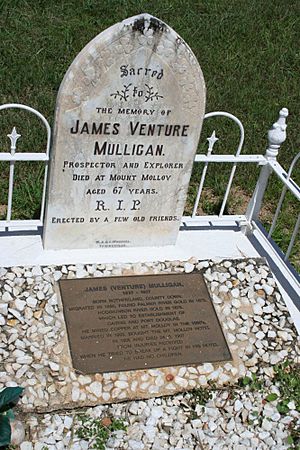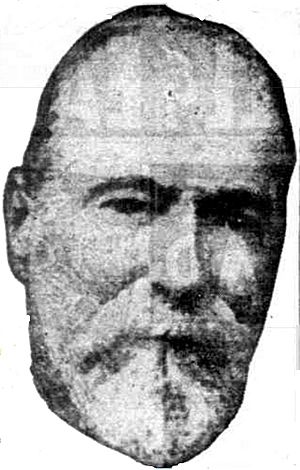James Venture Mulligan's Grave facts for kids
Quick facts for kids James Venture Mulligan's Grave |
|
|---|---|

James Venture Mulligan's Grave in Mount Molloy Cemetery, 2010
|
|
| Location | Bakers Road, Mount Molloy, Shire of Mareeba, Queensland, Australia |
| Design period | 1900 - 1914 (early 20th century) |
| Built | 1907 |
| Official name: James Venture Mulligan's Grave, Mt Molloy Cemetery | |
| Type | state heritage (landscape, built) |
| Designated | 21 October 1992 |
| Reference no. | 600684 |
| Significant period | 1907- (social) 1907-1938(historical) 1907(fabric-grave) 1907- (fabric-cemetery) |
| Significant components | grave surrounds/railings, grave marker, headstone, cemetery |
| Lua error in Module:Location_map at line 420: attempt to index field 'wikibase' (a nil value). | |
The James Venture Mulligan's Grave is a special heritage-listed grave. You can find it on Bakers Road in Mount Molloy, Queensland, Australia. It was built in 1907. This grave is also known as part of the Mount Molloy Cemetery. It was added to the Queensland Heritage Register on October 21, 1992.
Contents
Who Was James Venture Mulligan?
James Venture Mulligan was born in 1837 in County Down, Ireland. He came to Australia around 1859 or 1860. He first tried his luck in New South Wales, possibly opening a butcher's shop. Soon, he became very interested in finding gold.
Early Gold Discoveries
Mulligan joined the Gympie gold rush in 1867. He then explored other goldfields like Gladstone and Etheridge. He was known for being a great explorer and prospector.
In 1873, Mulligan led a team of six men. They went from Gilbert River to check on gold found by William Hann on the Palmer River. When Mulligan's team returned, they announced a big discovery. He had found "payable gold" on the Palmer River.
On September 26, 1873, Mulligan led 100 gold diggers to the Palmer. This discovery helped North Queensland grow a lot in the late 1800s.
More Expeditions and Discoveries
Mulligan explored the Palmer area and spent time in Cooktown. In 1874, he led another trip. He named the St George River and explored parts of the Mitchell and Walsh Rivers. He also found what would become the Hodgkinson goldfield.
In 1875, he led a government-funded trip. They passed future towns like Mareeba and Atherton. They found tin in the Wild River but not much gold. The government paid him to go on another expedition.
On October 23, 1875, Mulligan led another trip to the Hodgkinson. They returned with enough gold to start the Hodgkinson gold rush. This goldfield was active until 1909.
Life in Mount Molloy
In 1877, Mulligan settled in Thornborough. He owned a store and was involved in the local community. After his store faced problems, he went back to prospecting. He led more expeditions in the 1880s, searching for tin and gold.
Mulligan was respected for his bush skills and strong beliefs. He became a justice of the peace in 1894. In 1903, when he was in his early 60s, Mulligan married Fanny Bulls. They settled in Mount Molloy. At that time, Mount Molloy was a busy town with copper mines.
Mulligan's Final Years
The details of Mulligan's death are not fully clear. On August 23, 1907, he was involved in a fight. He was taken to Mount Molloy hospital and sadly died the next day. He was buried in the Mount Molloy cemetery. Local residents put up a marble headstone for him. It says he was 67 when he died, but he was actually 70. The headstone reads "erected by a few old friends."
Mulligan loved exploring as much as finding gold. He often shared his discoveries. His exciting diaries were published and helped guide people to goldfields. Places like Mount Mulligan and the Mulligan Highway are named after him.
Mulligan was connected to Mount Molloy from its early days. He led the first prospecting trip there. He also had a copper mining claim that was later sold. This mine became a top copper producer in North Queensland.
Mulligan's grave is the oldest marked grave in the Mount Molloy cemetery. The cemetery is still used by the community today. A bronze plaque and other memorials show how important he remains to the area.
About the Grave Site
James Venture Mulligan's grave is in the Mount Molloy cemetery. This cemetery is about 2.6 kilometers (1.6 miles) from Mount Molloy town. A low fence with three gates surrounds the cemetery.
The cemetery land is open and gently slopes. It has some trees like Acacia, Melaleuca, Eucalypt, and Grevillea. You might also see some termite mounds around.
Mulligan's Grave Details
Mulligan's grave is in the south-east corner of the cemetery. It is near a large grevillea tree. His grave has a marble headstone. It was made by W.A. & C. Whelan in Townsville. A concrete border and a white painted cast iron fence surround the grave.
Below the headstone, there is a bronze plaque. It is set in concrete and surrounded by white quartz pebbles. More loose white quartz pebbles are inside the concrete border. Other graves in the cemetery are made from materials like marble, granite, and concrete.
Why is it Heritage-Listed?
James Venture Mulligan's Grave in the Mount Molloy Cemetery was added to the Queensland Heritage Register on October 21, 1992. This means it is a very important historical site.
Showing Queensland's History
The Mount Molloy cemetery has been used since at least 1907. It shows how the region has grown over time. It helps us understand the history of early mining in the area. It also shows how the economy changed over the years.
Connection to Important People
James Venture Mulligan was very important in Queensland's history. He helped discover and open the Palmer goldfields. These goldfields greatly helped North Queensland develop in the late 1800s. He is also known for finding the Hodgkinson goldfield and other mineral sites.
Mulligan is remembered through his writings and places named after him. His grave is a direct and real reminder of him. It connects us to his life and the mining history of North Queensland.


